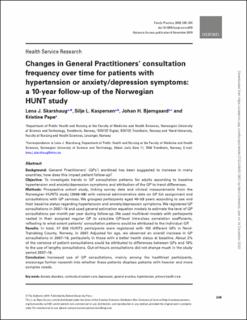Changes in General Practitioners’ consultation frequency over time for patients with hypertension or anxiety/depression symptoms: a 10-year follow-up of the Norwegian HUNT study
Peer reviewed, Journal article
Published version
Permanent lenke
https://hdl.handle.net/11250/2788426Utgivelsesdato
2020Metadata
Vis full innførselSamlinger
- Publikasjoner fra CRIStin - SINTEF AS [5802]
- SINTEF Digital [2501]
Sammendrag
Background: General Practitioners’ (GPs’) workload has been suggested to increase in many
countries; how does this impact patient follow-up?
Objective: To investigate trends in GP consultation patterns for adults according to baseline
hypertension and anxiety/depression symptoms and attribution of the GP to trend differences.
Methods: Prospective cohort study, linking survey data and clinical measurements from the
Norwegian HUNT3 study (2006–08) with national administrative data on GP list assignment and
consultations with GP services. We grouped participants aged 40–59 years according to sex and
their baseline status regarding hypertension and anxiety/depression symptoms. We registered GP
consultations in 2007–16 and used general estimation equation models to estimate the level of GP
consultations per month per year during follow-up. We used multilevel models with participants
nested in their assigned regular GP to calculate GP-level intra-class correlation coefficients,
reflecting to what extent patients’ consultation patterns could be attributed to the individual GP.
Results: In total, 47 550 HUNT3 participants were registered with 102 different GPs in NordTrøndelag County, Norway, in 2007. Adjusted for age, we observed an overall increase in GP
consultations in 2007–16, particularly in those with a better health status at baseline. About 2%
of the variance of patient consultations could be attributed to differences between GPs and 10%
to the use of lengthy consultations. Out-of-hours consultations did not change much in the study
period 2007–16.
Conclusion: Increased use of GP consultations, mainly among the healthiest participants,
encourage further research into whether these patients displace patients with heavier and more
complex needs.

